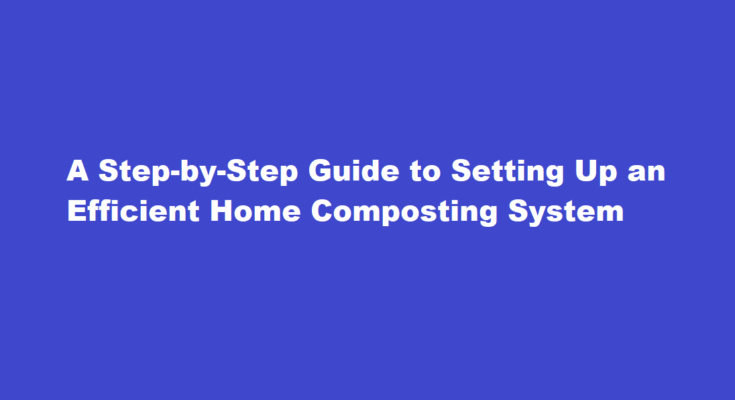Introduction
Composting is a sustainable and eco-friendly way to manage organic waste at home while reducing your carbon footprint. By turning kitchen scraps and yard waste into nutrient-rich compost, you can create a valuable resource for your garden, promoting healthy plant growth and minimizing landfill waste. Setting up a home composting system may seem daunting, but with the right approach, it can be a rewarding and straightforward process. This article provides a comprehensive guide on how to establish an efficient home composting system, allowing you to embrace greener living while nurturing your garden.
Choose the Right Location
The first step in setting up a composting system is selecting the ideal location. Choose a spot that receives partial sunlight, as composting microorganisms work optimally in temperatures between 50°F and 70°F (10°C to 25°C). Additionally, the chosen location should be easily accessible from the kitchen, allowing for convenient disposal of kitchen scraps.
Select the Composting Method
There are various composting methods to consider, each with its unique advantages. The two most common methods for home composting are
1. Backyard Composting This traditional method involves creating a compost pile directly on the ground. It is suitable for homeowners with larger gardens and ample yard space.
2. Compost Bins Compost bins are a more contained and space-efficient option, making them suitable for smaller yards or urban settings. They come in different materials, such as plastic, wood, or metal.
Gather Composting Materials
For successful composting, you’ll need a proper balance of green (nitrogen-rich) and brown (carbon-rich) materials
Green Materials Kitchen scraps like fruit and vegetable peels, coffee grounds, eggshells, and fresh yard waste like grass clippings.
Brown Materials Dry leaves, straw, shredded newspaper, and small twigs.
Avoid composting meat, dairy, and oily foods, as they can attract pests and slow down the composting process.
Start Composting
Now that you have your location, composting method, and materials ready, follow these steps to initiate the composting process
1. Create a Base If using a compost bin, place twigs or straw at the bottom to allow for proper aeration.
2. Layering Start by adding a layer of brown materials, followed by a layer of green materials. Continue alternating the layers to maintain the right carbon-to-nitrogen ratio, aiming for about 2:1 (carbon to nitrogen).
3. Add Water Moisten the compost pile as you build it. The compost should feel as damp as a wrung-out sponge.
4. Regular Turning For faster decomposition, turn the compost pile regularly (at least once a week) to aerate it. This encourages the breakdown of organic matter and prevents unpleasant odors.
Troubleshooting
Composting is a natural process, but sometimes issues may arise. Here are some common problems and solutions
1. Foul Odors Foul smells indicate improper aeration or too much moisture. Turn the compost pile more frequently and add dry brown materials to balance the moisture.
2. Pests If pests are attracted to your compost, avoid adding meat, dairy, or oily food waste. Additionally, cover the kitchen scraps with a layer of brown materials to deter pests.
Harvesting Compost
Compost is ready to use when it turns dark, crumbly, and has a pleasant earthy smell. The decomposition process usually takes anywhere from two to six months, depending on the composting method and environmental conditions. To harvest compost from a compost pile, stop adding new materials and let it sit for a few weeks to allow any remaining scraps to break down fully.
For compost bins, you can use a two-bin system, adding new materials to one bin while the other matures. Rotate between bins every few months to harvest fully composted material continually.
Using Compost
Congratulations! You now have nutrient-rich compost to enhance your garden’s soil health and boost plant growth. Mix the compost into your garden beds, use it as mulch, or blend it with potting mix for container gardening.
FREQUENTLY ASKED QUESTIONS
How do I set up composting at home?
This allows worms and other beneficial organisms to aerate the compost and be transported to your garden beds. Lay twigs or straw first, a few inches deep. This aids drainage and helps aerate the pile. Add compost materials in layers, alternating moist and dry.
What is the first rule of composting?
With composting, it helps to have a vision of what the entire process will look like.
Do compost bins smell?
A properly balanced compost pile should not smell bad. Compost should smell like dirt and if it does not, there is something wrong and your compost pile is not properly heating up and breaking down the organic material. There is one exception to this rule and that is if you are composting manure in your compost pile.
Conclusion
Setting up a home composting system is a valuable step towards sustainable living and reducing waste. By choosing the right location, selecting the appropriate composting method, and following a few simple steps, you can turn kitchen and yard waste into nutrient-rich compost for your garden. Embrace this eco-friendly practice, and not only will you minimize your environmental impact, but you’ll also create a thriving garden that flourishes with the help of your homemade compost.
Read Also : Mastering The Art of Baking Irresistible Chocolate Chip Cookies from Scratch



